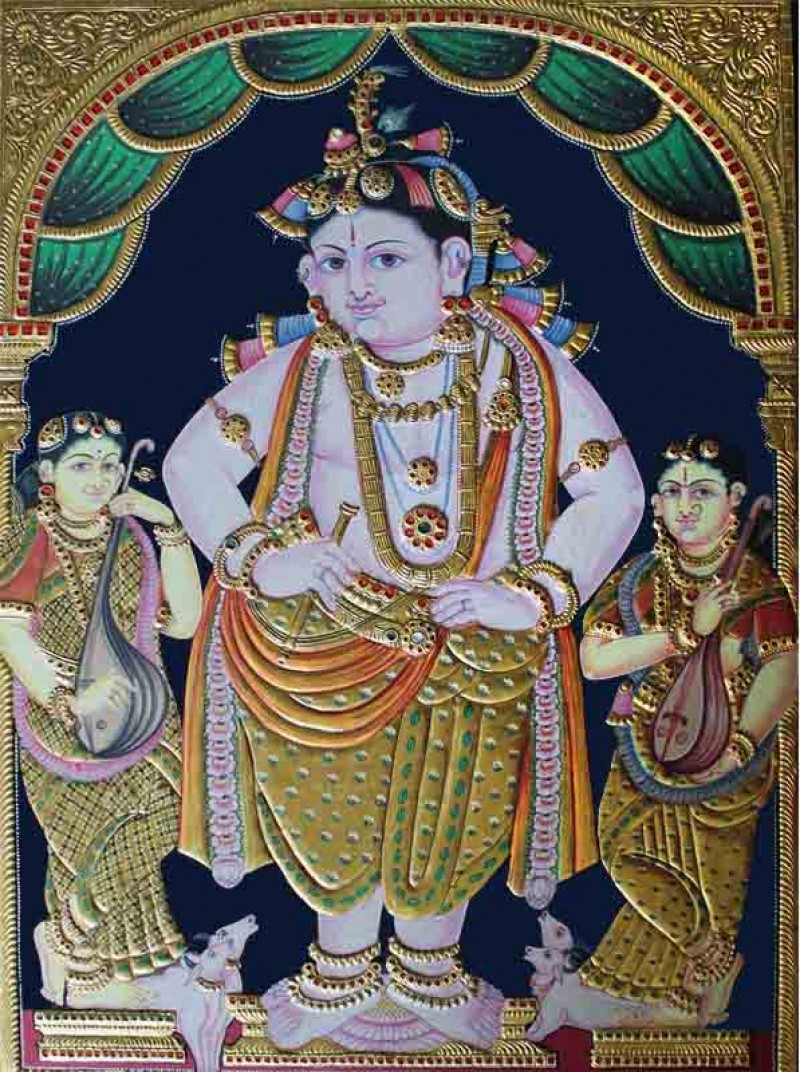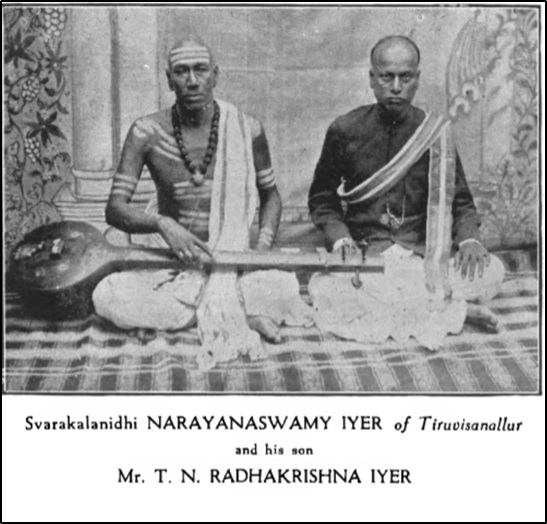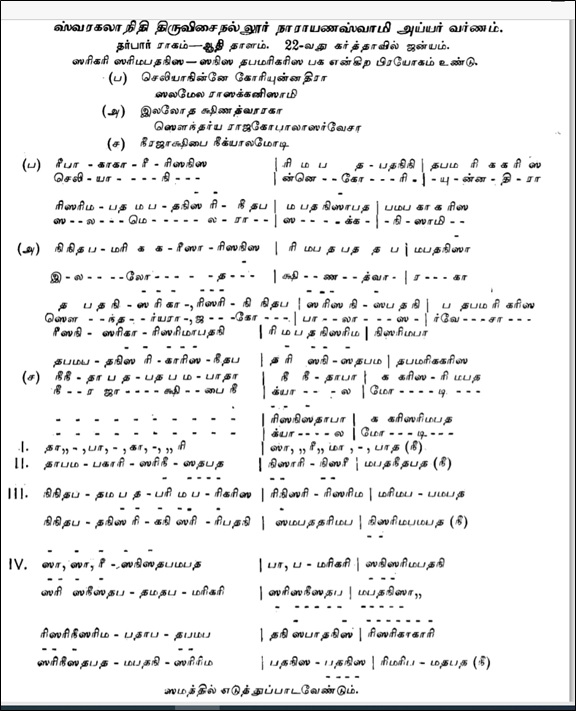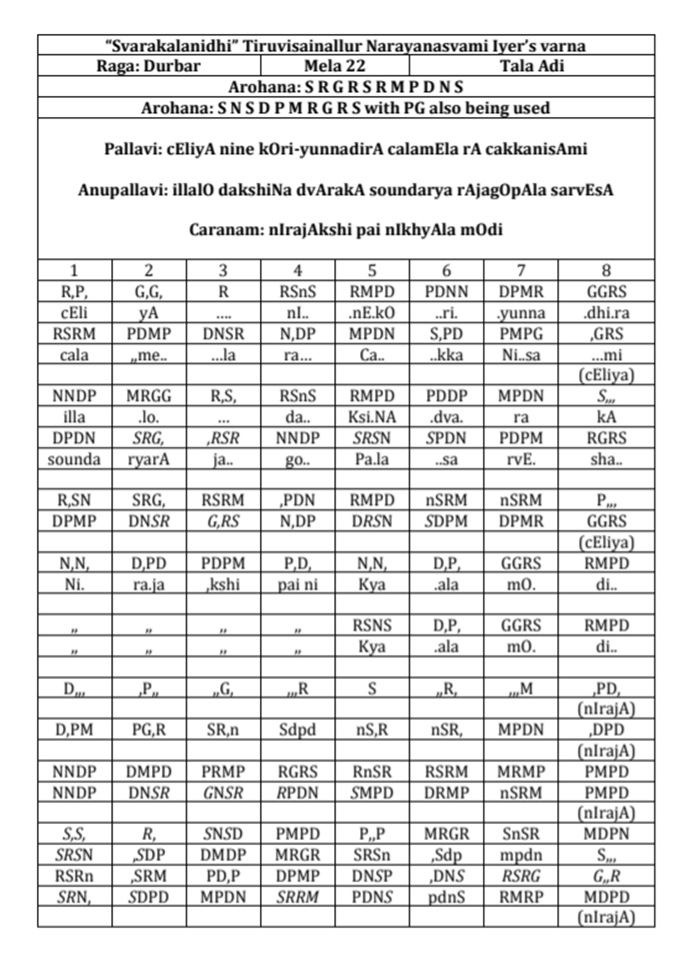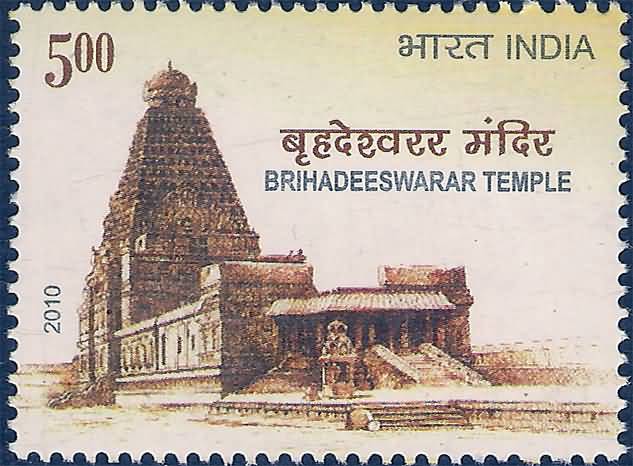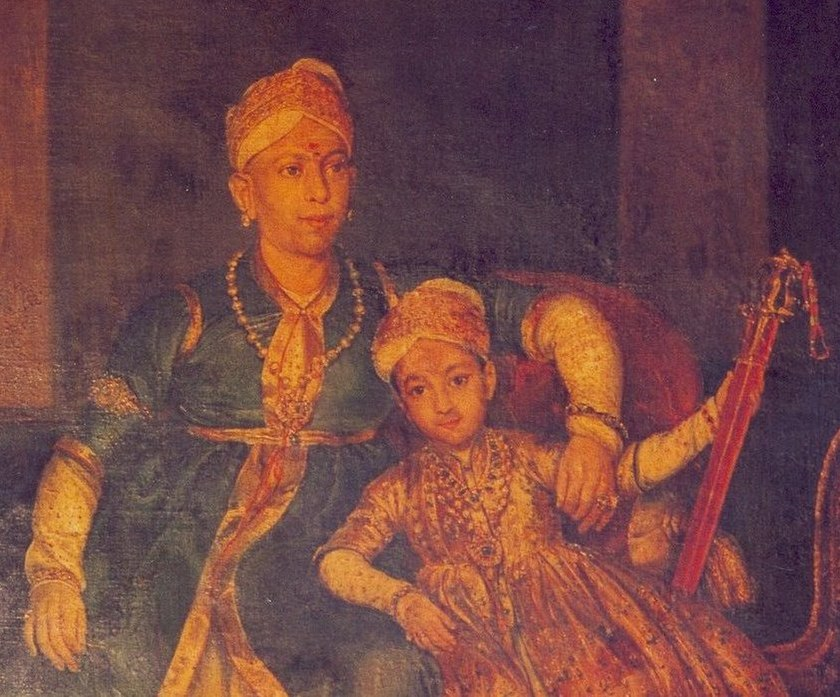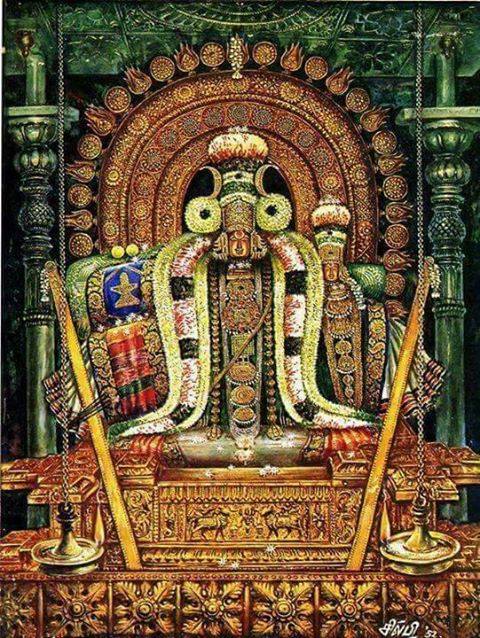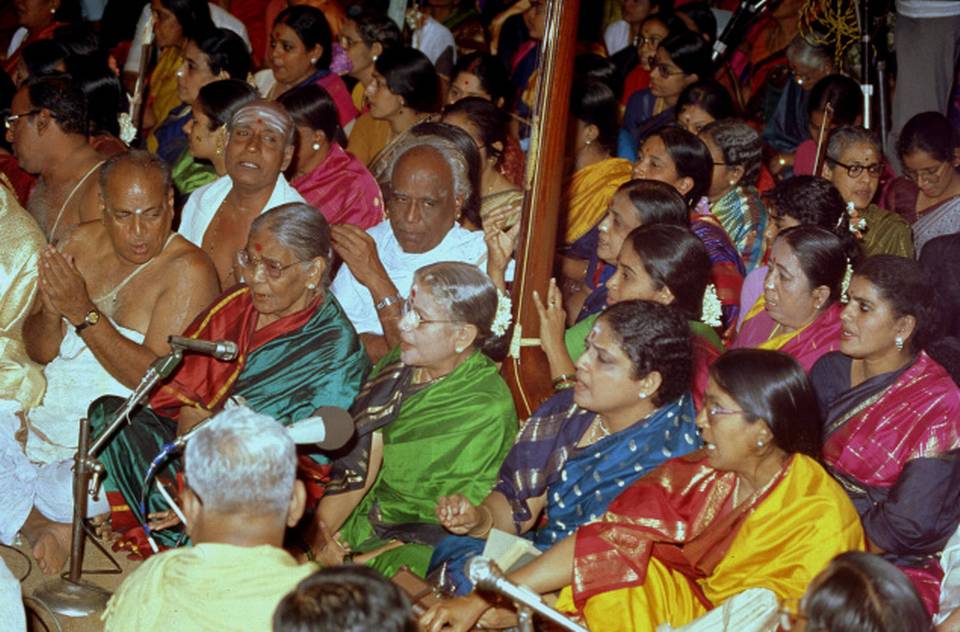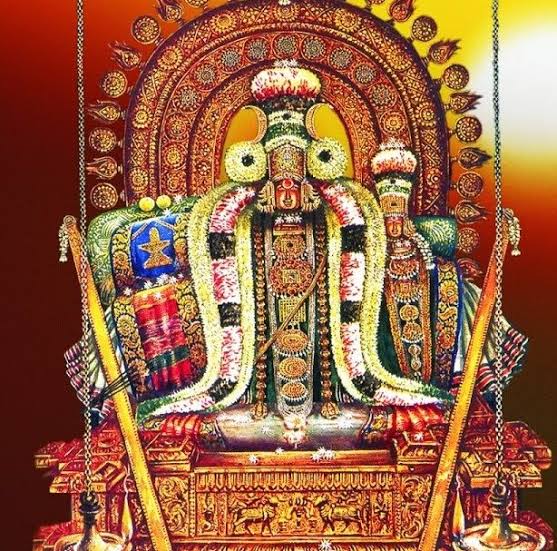[simple-author-box]
Prologue:
At the very outset before we deal with the raga Sarasvati Manohari as documented in the Sangita Sampradaya Pradarshini (SSP) of Subbarama Dikshita in this blog post, the following disclaimers are in order:
- This raga as documented in the SSP, belongs to the 29th Mela and it has nothing to do with the melody as found in “Entha Veduko” of Tyagaraja, which is provided with the name of Sarasvati Manohari as well but is under the 28th Mela.
- The raga name “Sarasvati Manohari” has been assigned to the melody of “Entha Veduko” of Tyagaraja by all musical authorities post 1900 AD on the authority of the Sangraha Cudamani which is purportedly the lexicon of the ragas of the compositions of Tyagaraja. It has been reiterated in these blog posts that the “Sangraha Cudamani” is a musical text of a much later vintage (19th century, most probably second half) in comparison to the Anubandha of Muddu Venkatamakhin which is dateable at the latest to 1750AD. The views of the noted music critic K V Ramachandran, the man who discovered the Sangraha Cudamani in the Adayar Library, in this regard are recorded for posterity and in these blogs as well. ( See Reference section below)
- Therefore, in our discussion of this raga in this blog post we will not be referring at all to the raga as found in “Entha Veduko” or the treatment thereof under Sangraha Cudamani. All references are to the treatment of the raga as found in the SSP.
- The authority for the raga Sarasvati Manohari under Mela 29 as documented in the SSP, comes from the three unassailable 18th century authorities (the Triad as we refer to these three texts in unison in these blog posts) of the likes of Sahaji (circa 1700 AD) , Tulaja (circa 1832 AD) and Muddu Venkatamakhin (1750AD) and crystallized with the exemplar composition of Muthusvami Dikshita.
- It’s a folly to talk of the Sarasvati Manohari of Tyagaraja and the Sarasvati Manohari of Dikshita given the weight of historical evidence we have in this regard. In these blog posts it is simpliciter stated the raga names as found in the Anubandha and documented in the SSP, are much older and are of far greater antiquity and authority. The assignment of such older names of ragas to the melodies of the compositions of Tyagaraja (such as Sarasvati Manohari) without relevance as to the identicality, was a post 1850 AD development. In fact, it is on record that Tyagaraja never revealed the raga names when he taught the compositions to his disciples and only much later after his death with the advent of printing did the assignment of raga names to the melodies happen. The effect was that in quite many cases wrong names came to be assigned to the ragas arbitrarily without taking into account the textual history of the raga concerned. Sarasvati Manohari is one such victim of misnaming whereby the older raga name came to be assigned to the melody of “Enta Veduko” without effecting a check whether the melody found in the composition corresponded to the scale of the raga as per grammar.
- Ironically today so synonymous is the raga name “Sarasvati Manohari” with “Enta Veduko” so much so that the actual or true melodic identity which is found in Dikshita’s composition “Sarasvati Manohari” is looked upon with suspicion!
- And it has to be placed on record that this aberration which came to be inflicted on this raga cannot and should not be used to advance the proposition that the raga itself evolved by dropping N3 and acquiring N2, as we have musical history of spanning 1700 to 1906 AD recording the raga as a janya of Mela 29. The raga of “Enta veduko” should have been assigned another new name without any confusion whatsoever, leaving the older name of “Sarasvati Manohari” out of this entire controversy. This mis-assignment of name is a self-inflicted wound by us on our very known musical theory and musicological history without any justification whatsoever. The only way is to acknowledge this aberration ex facie, and safely navigate the study of ragas and raga lakshanas, rather than trying to justify the same needlessly.
With these disclaimers in place, in this blog post we will embark on dissecting this old raga which is hardly ever rendered in the modern concert stage, save for the occasional rendering of just the kriti of Dikshita, sans alapana, neraval or svaraprastara.
It is reiterated that the raga Sarasvati Manohari of Dikshita is under Mela 29 (Sankarabharanam with N3) as documented in his composition “Sarasvati Manohari”, beginning on the raga mudra itself and no attempt should be made to corrupt the same and attempt to render it under Mela 28 by replacing the N3 with N2. There is no authority for it whatsoever in either the textual or the oral traditions.
Contours of the raga as found in Dikshita’s Composition:
On an entirely different note it can be demonstrated that the kritis of Muthusvami Dikshita are best understood by triaging the lakshana as found in the composition with the stated grammar of the raga in the “Triad” of musical works which are Sahaji’s “Raga Lakshanamu” (circa 1700 AD), Tulaja’s “Saramruta” (circa 1832 AD) and the “Ragalakshanam” of Muddu Venkatamakhin ( circa 1750 AD) being the Anubandha to the original Caturdandi Prakashika of Venkatamakhin ( the main text which is dateable to circa 1620 AD).
The SSP records for us by way of a snapshot, the composition (being the notation) and the raga lakshana which is the sole basis for this blog post and the analysis thereof. In the instant case, the treatment of the raga Sarasvati Manohari by Dikshita will be investigated to derive a proper understanding by solely looking at:
- The documentation as found in the SSP and other ancillary sources which have a high-fidelity nexus to the musical heritage of Muthusvami Dikshita
- The details for the raga as found in the “Triad” of musical works
- The oral renderings of the compositions as passed on to us being authentic versions or pAtAntharams.
This blog post has to be read focussing only on the above and any other extraneous material outside of the above is patently irrelevant for the subject on hand and hence a discussion on those is safely avoided. And which is why the aforesaid disclaimers become important in the context of this discourse.
The raga according to Subbarama Dikshita:
The SSP records the lakshana of the raga strictly in line with the “Ragalakshanam” of Muddu Venkatamakhin (circa 1750 AD) along with Subbarama Dikshita’s commentary and does not record the lakshana as found in the works of Sahaji and Tulaja. According to the SSP the following are the features of the raga:
- The raga is a bashanga janya of Sankarabharanam according to the SSP. For us in modern parlance it can be safely concluded that the raga is an upanga janya and takes only the notes of the parent Mela 29 only. It has been pointed out earlier that the term upanga/bashanga as used in the SSP, connotes a very different attribute of the raga and not the modern meanings that are ascribed to the said terms. The unassailable point here is that from a modern musicological perspective, the raga is without doubt upanga and the native nishadha note of the raga is N3 or kAkali variety only.
- The raga is sampurna and carries all the 7 notes, taking the arohana and avarohana together.
- Pancama is varjya or dropped in the arohana. Therefore MPD prayoga should be eschewed.
- Rishabha is vakra or deviant in the descent.
- Dhaivatha is the jiva svara of the raga.
- Despite the nominal arohana and avarohana progression of the raga being SRGMDDNS/SNDPMGMRS (as seen in the Ragalakshanam anubandha), DNS prayoga is not seen in the compositions.
- Therefore, the operative arohana progression of the raga is more like SRGM-DP-MDS or SRGM-DNDS or SRGMDDS
- Similarly, the operative avarohana progression is SNDPMGMRS or SNDNP-MGMRS
The perusal of the SSP would reveal the following beyond Subbarama Dikshita’s narrative.
- The Sankarabharana lakshya gita, lists Sarasvati Manohari as a bhashanga janya of the raga.
- The lakshya gita of the raga eschews DNS in toto despite the fact that the nominal arohana states DNS occurring.
- Though the sloka as found in the Anubandha cited in the SSP refers to the raga name as “sarasvata manohari”, Subbarama Dikshita labels the raga as “sarasvatI manOhari” only.
Armed with the above details let us look at the evidence provided by Sahaji and Tulaja in their respective works as to this raga.
“Sarasvati Manohari” according to Sahaji and Tulaja:
- The raga is named only as Sarasvati Manohari.
- Both the royal authors are unanimous in their view that pancama and nishadha are skipped in the arohana and gandhara in the avarohana.
- In fact, SRGMDDS and GMDDNDPM are oft repeated murrcanas in the raga.
- In essence MPD, DNS and MGRS are forbidden murrcanas of the raga.
In fact amongst the Triad, Sahaji and Tulaja are completely ad idem on the lakshana while Muddu Venkatamakhin alone strikes the sole discordant note by allowing DNS prayoga. However, Subbarama Dikshita explains away this sole discordance stating that DNS is not seen in practice.
Summary of the raga lakshana according to the Triad:
From the foregoing the raga lakshana can be restated in the classical 18th century vernacular as under:
- Sankarabharana is the mela or the raganga under which Sarasvati Manohari is classed.
- The raga is sampurna and all the 7 notes occur in its body and the notes are S, R2, G3, M1, D2 and N3. No other variety of the notes occurs.
- Pancama and nishadha are dropped in the arohana.
- Gandhara is vakra in the avarohana.
- Dhaivatha is a prime note emphasized via the repeated/janta notes.
- PDNS, MPD and DNS are forbidden in the arohana krama; MGRS is forbidden in the avarohana krama.
- SRGM, GMDD, PMDD, SNDP, NDPM, SNDNP, GMRS are the permitted murrcanas which join together to form the skeletal structure of the raga.
Dikshita’s Implementation of Sarasvati Manohari:
The notation of the Dikshita composition which begins with the raga name itself as its refrain reveals the following:
- d/R and D/r being the jump from mandhara dhaivatha to madhya rishabha and madhya dhaivatha to tara rishabha is seen repeatedly used apart from d/G and D/g as well.
- GMDP, MGMDD, RG-GMR, SNDSN, SNPM, RGMND are seen used in the composition aligning to the 18th century definition of the raga as laid.
- In the arohana krama RGMP cannot be used while RGMDP is permissible.
- The two madhyama kala sahitya portions provide a pithy/concise delineation of the raga’s lakshana.
- And the kriti is littered with svaraksharas particularly of the rishabha and pancama notes.
Key take-ways from the analysis:
- It is thus seen that Dikshita has meticulously stuck to the early 18th century version of the raga as documented by Sahaji and Tulaja, keeping out the DNS prayoga as well. His novelty has been the employment of the d/R and D/r, which is seen in Purnachandrika as a leitmotif. Dikshita has also eschewed DDS and is consistently seen approaching the tara sadja via the tara rishabha and not directly from the madhya dhaivatha.
- The raga shines forth with its native progressions being SRGM, GMDD, PMDD, SNDP, NDPM, SNDNP, GMRS, GMDP, MGMDD, RGMR, SNDSN, SNPM and RGMND.
- The raga may be considered as melodically close to modern Kannada which is different from the Kannada as documented in the SSP. In contradistinction, the Kannada of the SSP sports N2 prominently and is classed under Mela 28. In this context care should be taken in rendering Sarasvati Manohari as the phrase SNS is likely to creep in. the phrases SNDP or SNDS alone are allowed in contradistinction to modern Kannada.
- Under the SSP the raga Suddha Vasantha (under Mela 29) is a close raga which shares a common melodic bonding with Sarasvati Manohari and unfortunately the SSP does not record any composition of Dikshita is this raga.
- The two ragas namely Kannada and Suddha Vasantha are also documented by Sahaji and Tulaji under Mela 28 and 29 respectively and thus it may not be of much help.
- In summary a simple compare of Sarasvati Manohari with modern Kannada can help us differentiate and understand the ragas better.
| Attribute | Sarasvati Manohari of SSP | Modern Kannada |
| Mela | 29 | 29 |
| Type | Upanga | Upanga |
| Arohana purvanga | SRGM | SGM and SMGM |
| Arohana uttaranga | DDS and DrS | MDNS ;PMDNS |
| Arohana krama | SRGMDDS | SMGMPMDNS |
| Avarohana uttaranga | SNDP and SNDNP | SNSDPM |
| Avarohana purvanga | PMGMRS | PMGMRS |
| Arohana krama | SNDP or SNDNP-PMGMRS | SDPMGMRS |
| Differences inter se -arohana | Pancama and nishadha are dropped; SRGM and GMDP are permitted | Rishabha & Pancama are both dropped in the ascent |
| Differences inter se-avarohana | SNDP and SNDNP are the permitted prayogas | Nishada is dropped in the descent. |
In summary the difference between the ragas is slender and the Dikshita composition does well to capture the difference and also emphasizing the d/R prayoga given that rishabha is a much muted svara in modern Kannada.
It has to be recorded that “Sri Matrubhutam” of Muthusvami Dikshita is today rendered only in modern Kannada, thoroughly eschewing the N2 note which is supposed to dominate the raga Kannada according to SSP, which classes the raga under Mela 28, with N3 being an anya svara ( a bashanga janya under Mela 28).
From a practical perspective Sarasvati Manohari can be distinguished by emphasizing SRGM and SNDP prayogas along with d/RR, D/rr so as to safely keep Kannada out of the ken of the raga delineation.
Some collateral data points:
The “Dikshitar Keertanai Prakashikai” (DKP) published by Tiruppamburam Natarajasundaram Pillai (a disciple of Satanur Panju Iyer of the Dikshita sisya parampara) records this composition only under Mela 29without any ambiguity whatsoever. In fact, this composition was taught both to Natarajasundaram Pillai and to Veena Dhanammal by Satanur Panju Iyer who was their guru and it can be seen that the version tallies if the notation in DKP is compared with the oral version of the composition as sung by Sangita Kalanidhi Smt T Brinda, the scion of the Dhanammal tradition.
Apart from this the version of the composition as rendered by Sangita Kalanidhi Smt D K Pattammal, who in turn traces her pAtham to Justice T L Venkatrama Iyer and on to Ambi Dikshita son of Subbarama Dikshita, is aligned to the version as seen in the SSP.
We will review these two oral versions in the discography section.
The Composition:
pallavi
sarasvatI manOhari – O one who captivates the heart of Goddess Sarasvati!
Sankari – O wife of Shiva (Shankara)!
sadA-Ananda lahari – O eternal wave of bliss!
gauri – O fair one!
Sankari – O the beneficent One!
anupallavi
sarasI-ruha-akshi – O lotus-eyed one!
sadASiva sAkshi – O one always with Sadashiva
karuNA kaTAkshi – O one with compassionate side-glances!
pAhi – Protect (me)!
kAmAkshi – O Kamakshi!
mura hara sOdari – O sister of Vishnu (slayer of the demon Mura)!
mukhya kaumAri – O eminent Kaumari!
mUka vAkpradAna-kari – O giver of speech to the mute poet Mooka!
mOda-kari – O source of bliss!
caraNam
akAra-Adi-akshara svarUpiNi – O embodiment of all the letters beginning with “a”!
antaH-karaNa rUpa-ikshu cApini – O one who has a sugarcane-bow that represents the mind!
prakASa parama-advaita rUpiNi – O shining embodiment of supreme non-dualism!
parE – O supreme one!
tripura sundari – O Tripurasundari!
tApini – O glowing, effulgent one!
prakalpita prapanca prakASini – O one who shines forth as this created universe!
prasiddha guru guha janani – O mother of the renowned Guruguha!
pASini – O one holding a noose!
vikalpa jaTila viSva viSvAsini – O one who is reliable in this diverse, complicated universe!
vijaya kAncI nagara nivAsini – O one dwelling in the victorious city of Kanchi!
Notes:
It can be seen from the composition that:
- The composition is on Goddess Kamakshi of Kancipuram as it is so stated unambiguously.
- The raga mudra occurs right at the beginning of the composition and has been used to mean that Goddess Kamakshi is one who captivates Goddess Sarasvati. The epithet is reminiscent of the opening lines of the Manji composition “Sri Sarasvati Hite” meaning “O the benefactress of Goddess Sarasvati”.
- The phrase “akArAdyA-kshara svarupini” reminds one of the similar phrase – “ahantA svarUpini” occurring in “Brihannayaki Varadayaki” in Andhali.
- The composer’s colophon “guruguha” occurs as well in the composition which is set in Adi tala.
Sarasvati Manohari featured in the ragamalika “pUrna candra bimba”
Apart from this solitaire, the raga is also found featured in the ragamalika which is found documented in the Anubandha to the SSP. There are those who argue that this ragamalika being bereft of Dikshita’s colophon “guruguha” is not his but that of Ramasvami Dikshita. Be that as it may, Subbarama Dikshita has assigned the same to Muthusvami Dikshita in the Anubandha. The said ragamalika features ragas which are only janyas of Mela 29 Sankarabharana and they being Purnchandrika, Narayani, Saravati Manohari, Suddha Vasantha, Hamsadhvani and Nagadhvani.
The lyrics “pUrna phala prada caranE sarasvati manoharI” being the second anupallavi section to the main pallavi section being “pUrnacandra bimba vijaya vadanE kamalAbikE”, is set in Sarasvati Manohari. The notation and lyrics in rupaka tala runs thus:
| 1 | 2 | 3 | 1 | 2 | 3 |
| G, | MD | P, | MD | MG | M, |
| pU | rNaph | ala | prada | cara | nE |
| S/R | ,S | n, | pd | ,d | R, |
| sara | sva | tI | manO | ,ha | rE |
As can be seen the motif d/R being Dikshita’s novelty or improvisation as to this raga is seen employed with the overall grammar of the raga being in accordance with what is seen in the kriti “Sarasvati Manohari”. This can perhaps be taken as a point of evidence that this composition is likely to be Dikshita’s given the employment of his novel leitmotif, which is not seen in the generic raga lakshana.
Discography:
Sangita Kalanidhi T Brinda renders the composition “Sarasvati Manohari” here:
http://www.sangeethamshare.org/tvg/UPLOADS-1201—1400/1376-T-Brinda-Muthuswamy_Dikshithar_Krithis/
Sangita Kalanidhi D K Pattammal sings the composition “Sarasvati Manohari” here:
http://www.sangeethamshare.org/ksj/D-K-Pattammal/DKP–004–Dikshitar-Day-/
(Google/Yahoo ID would be required. Hit the URL and scroll down the items listed in the page)
Sangita Kalanidhi M Balamuralikrishna renders “Purna candra bimba” in this recording. Saravati Manohari portion is featured between 3:36 -4:10. The said portion of the rendering accords with the notation found in the Anubandha for the composition.
Conclusion:
Musical history must be properly evaluated and understood and due regard must be had to the authentic versions of the compositions as passed on to us. The fact that raga name Sarasvati Manohari came to be wrongly assigned to the raga of “Entha Veduko” should be acknowledged which would help us in appreciating the creations of both Tyagaraja and Dikshita for their individual beauty, without any confusion whatsoever. Tyagaraja spun many nouveau ragas which weren’t in existence prior to his times and his kritis are the sole exemplars for those ragas. The raga of “Entha veduko” too is one such creation of his, which must have been assigned a new name, instead of repurposing an existing older raga name causing confusion for all concerned. Further no normalization should be inflicted by attempting to render Dikshita’s kriti with N2 or Tyagaraja’s with N3. Each kriti should be preserved and sung as documented. And if we do this Sarasvati Manohari is no conundrum for anyone.
It is indeed sad that discussions and lecture demonstrations are held, the subject being how the same raga has apparently been dealt with differently by Dikshita and Tyagaraja, without realizing the folly committed in the late 19th century and perpetuated into the 20th century and till date. It is humbly submitted and hoped that the Music Academy will take the lead in documenting this anomaly formally and assign newer names to these ragas of Tyagaraja so that the same is not just recorded for posterity but also serves to illuminate students and listeners alike, with the confusion being avoided once and for all.
References:
- Subbarama Dikshitar (1904) – Sangita Sampradaya Pradarshini – Republished in Tamil by Madras Music Academy (1977) -Part IV- Mela 29 Pages 915-919
- Dr Hema Ramanathan (2004) – ‘Ragalakshana Sangraha’- Collection of Raga Descriptions pp 1261-1264
- Sangita Kalanidhi T V Subba Rao & Dr S R Janakiraman (1993)- “Ragas of the Sangita Saramruta” – Published by the Madras Music Academy – pp 113-118
- Dr R Sathyanarayana (2010)- “Ragalakshanam” of Sri Muddu Venkatamakhin- Published by IGNCA
- Ramachandran K.V. (1950) – “Carnatic Ragas and the Textual Tradition” – The Journal of the Music Academy XXI, pp. 99-106, Madras, India.
- Ramachandran K.V. (1950) – “Apurva ragas of Tyagaraja’s Songs” – The Journal of the Music Academy XXI, pp. 107-109, Madras, India.
Acknowledgement/Credits:
The Kamakshi icon painting, being the featured image in this blog post heading is by artist Shri Rajeshwar Nyalapalli and was sourced from his online webstore.


